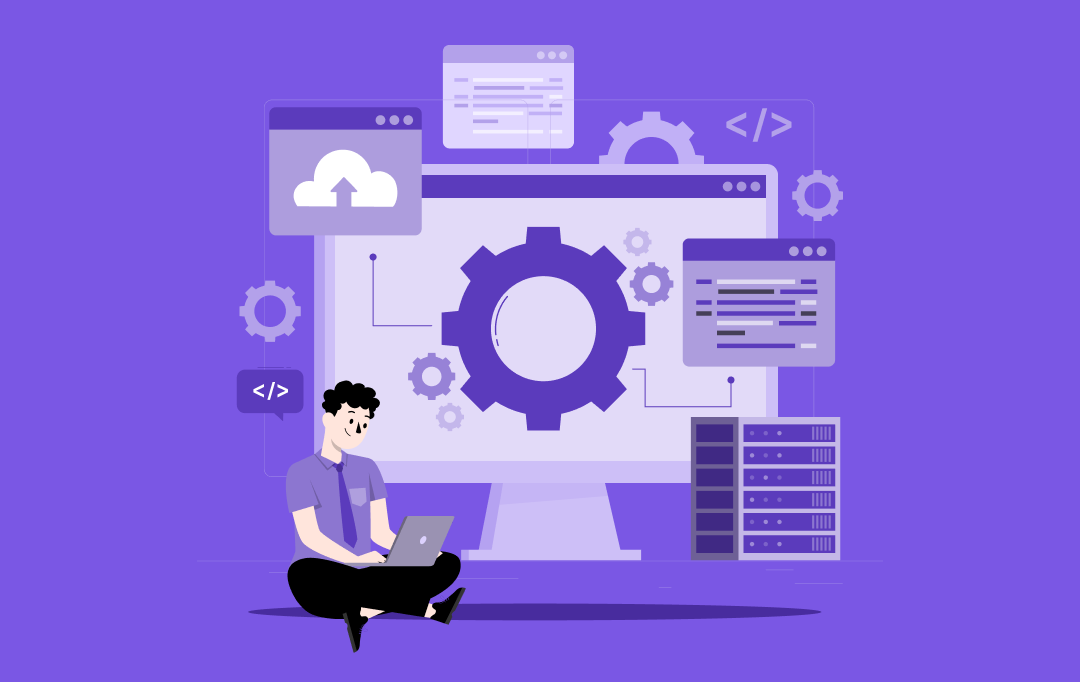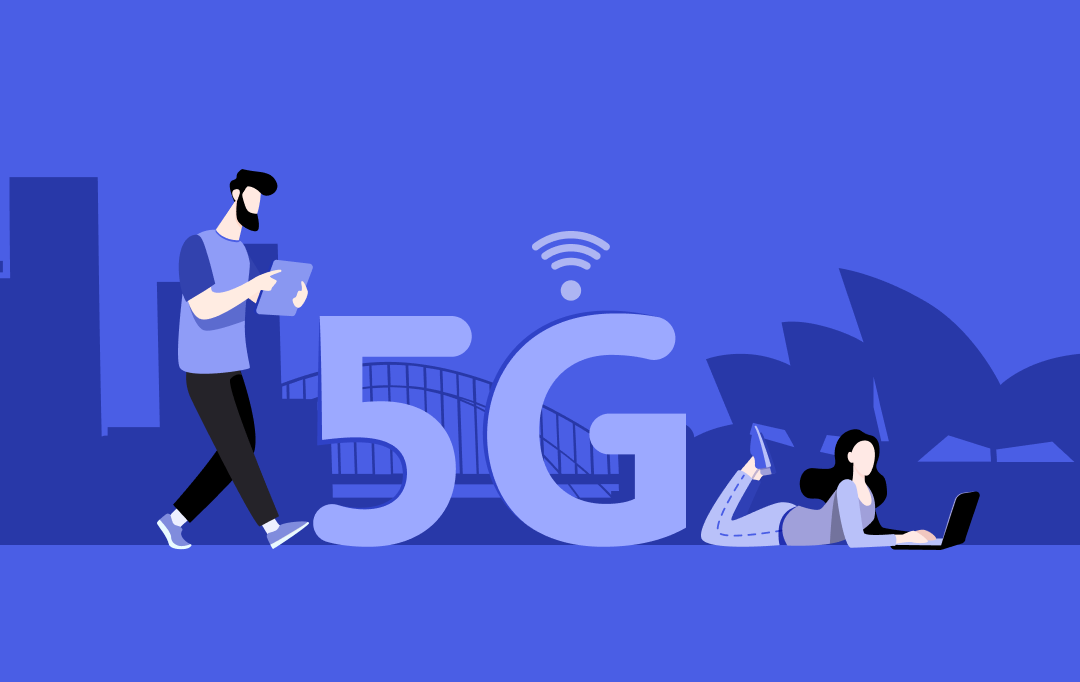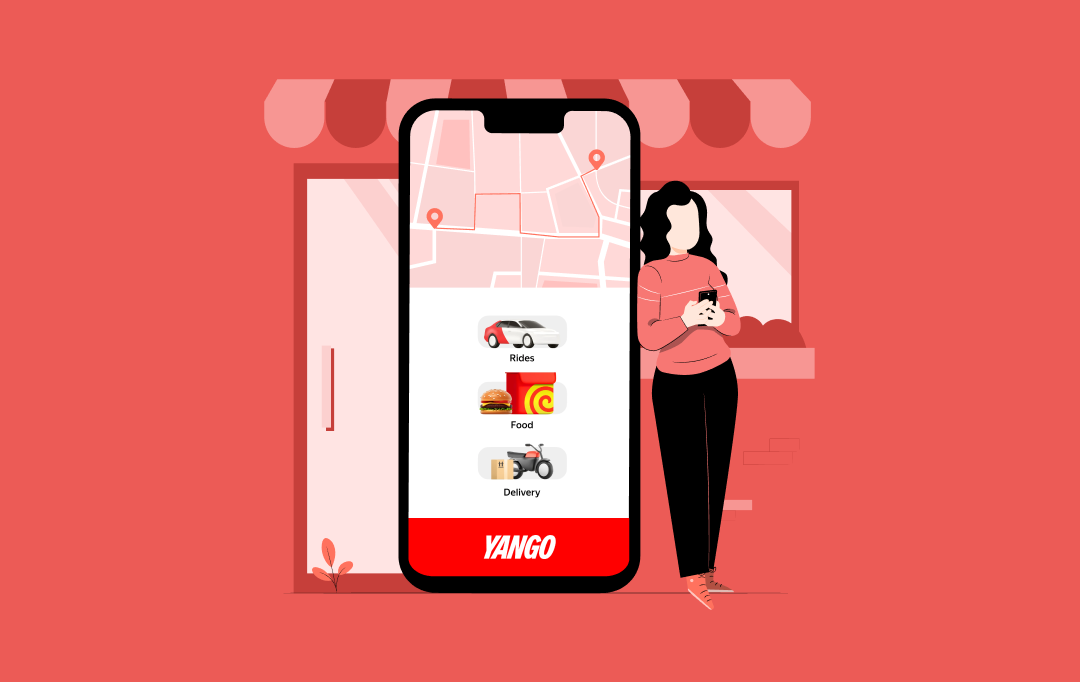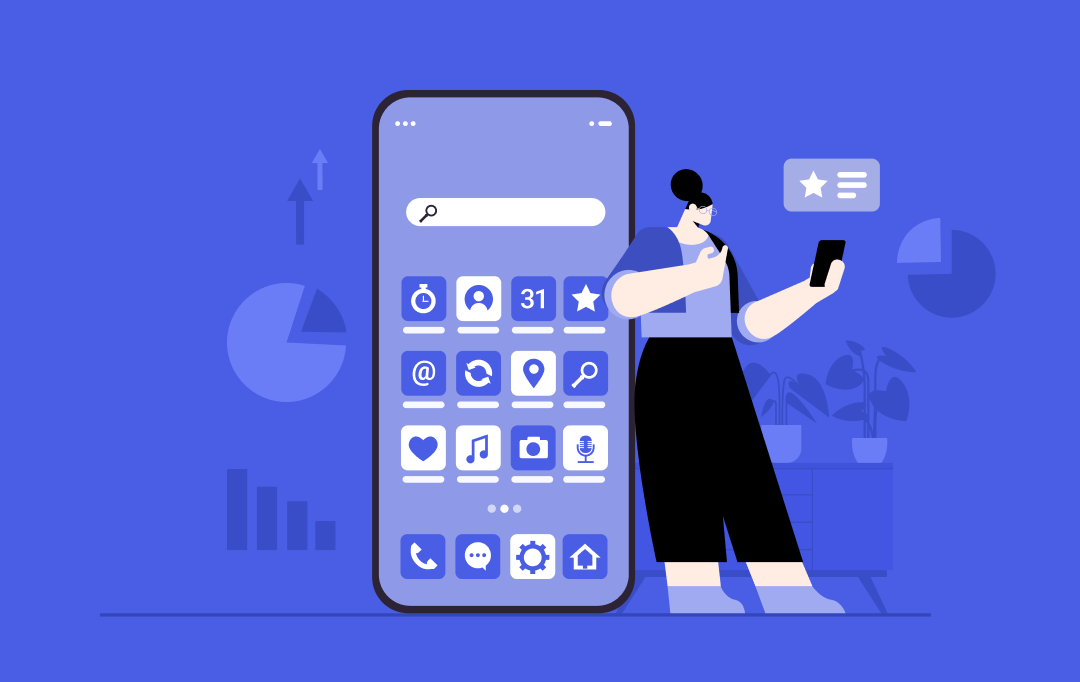Loyalty programs have evolved from simple stamp cards to sophisticated digital ecosystems that influence consumer behavior, enhance brand engagement, and drive repeat purchases.
According to Queue, more than 90% of companies now have some form of loyalty program. This includes big brands like McDonald’s, Walmart, Disney, Amazon, Costco, The Home Depot, Target, Best Buy, Nike, Adidas—the list goes on and on.
Flybuys has set a benchmark among the leaders in this space with its seamless omnichannel experience, AI-driven personalization, and real-time transaction processing. The app is not just a rewards platform; it’s a data-driven engine that helps businesses understand customer preferences and optimize their offerings.
For companies looking to develop a similar loyalty app, the cost to build a customer loyalty program app like Flybuys is a crucial consideration. The cost isn’t just about coding an app; it’s also about creating an infrastructure that can handle millions of transactions, integrate with retail POS systems, and provide a frictionless user experience. Because of this complexity, the final price tag depends on various factors, including features, backend architecture, third-party API integrations, security standards, and ongoing maintenance.
Beyond development, businesses must also consider the operational costs: cloud hosting, customer support, analytics, and compliance with evolving data privacy regulations.
In this article, we’ll break down every component of the customer loyalty program app development cost, from MVP development to full-scale deployment, which typically ranges from $40,000 to $5,00,000 (AUD 40,000 TO AUD 5,00,000), helping you understand what it takes to build an app like Flybuys and whether it aligns with your business goals.
Overview: Flybuys, A Loyalty Program App
Loyalty is no longer just about points. It’s about recognition, exclusivity, and seamless digital experiences. Today’s consumers don’t just want rewards; they expect them to be relevant, personalized, and easily accessible.
1. A report by Bond Brand Loyalty revealed that 79% of consumers are more likely to do business with a brand with a loyalty program. Still, nearly half feel that existing programs fail to deliver meaningful value. This gap presents an opportunity for companies looking to invest in customer loyalty program app development like Flybuys that truly engages users.
2. The biggest shift in customer sentiment comes from the rise of experience-driven loyalty. Shoppers aren’t just looking for discounts; they want real-time incentives, AI-powered recommendations, and multi-brand ecosystems where points hold tangible value.
3. Flybuys has mastered this by integrating with major retailers, airlines, and financial services, allowing users to earn and redeem points across different spending categories.
Any business planning to develop a similar platform must prioritize partnership-driven growth to maximize customer engagement. Additionally, mobile-first behavior has transformed how users interact with rewards programs. Traditional plastic cards have become obsolete; customers want their loyalty programs to be digitally embedded into their shopping journey, whether through in-app payments, contactless transactions, or seamless eCommerce integrations.
Cost Breakdown of Building an App Like Flybuys
The process to develop a customer loyalty program app like Flybuys involves more than just coding; it requires a scalable backend, high-performance analytics, and seamless integrations with payment gateways, retailers, and customer engagement tools. Simply put, the cost to build a customer loyalty program app typically ranges from $40,000 to $500,000 (AUD 40,000 TO AUD 5,00,000).
Basic Loyalty App (Minimal Features, Small User Base)
Cost Estimate: $40,000 – $80,000
What You Get: A simple mobile app with user registration, points tracking, and basic redemption options. This level suits small businesses or startups looking to test the market.
Mid-Level Loyalty App (Scalable, AI-Driven Insights, Multi-Brand Support)
Cost Estimate: $80,000 – $180,000
What You Get: A more refined experience with AI-driven recommendations, multi-brand partnerships, a more advanced backend for real-time transactions, and initial API integrations with retail POS systems.
Enterprise-Grade Loyalty App (High-Scale, Multi-Platform, Real-Time Analytics)
Cost Estimate: $200,000 – $500,000+
What You Get: A robust system capable of handling millions of users, advanced AI-powered personalization, fraud detection mechanisms, multi-currency transactions, and deep data analytics to optimize customer engagement strategies.
Beyond development, the ongoing customer loyalty program app development cost in Australia also comes into play cloud hosting, database management, API maintenance, and customer support can add $10,000 – $50,000 per year, depending on scale and complexity.
Factors Influencing the Cost of Customer Loyalty Program App
Several key factors affect the development costs of the customer loyalty program app. The complexity of features such as user authentication, reward systems, and building push notifications significantly impacts the overall budget.
Integrating advanced technologies like AI-driven sentiment analysis or personalized customer engagement tools can also increase development costs. The platform choice—iOS, Android, or both—also plays a vital role, as building multiple platforms requires more time and resources. Furthermore, ensuring a seamless user experience through intuitive design, robust security measures, and continuous updates adds to the overall expense.
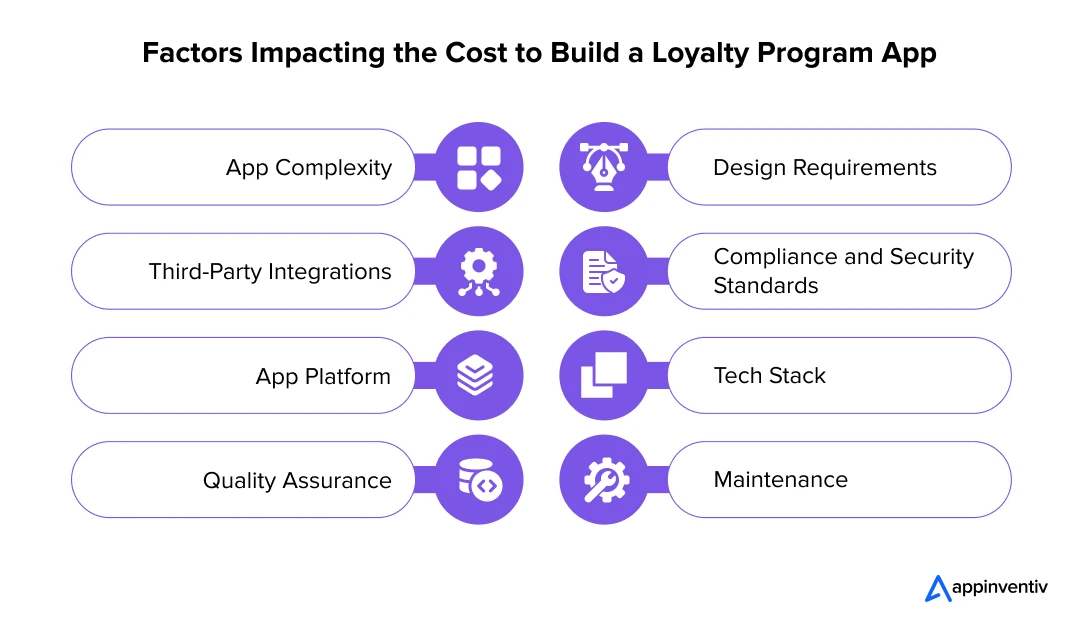
App Complexity
The complexity of an app significantly influences the cost to build a customer loyalty program app like Flybuys.
- Basic apps with limited features, such as a digital loyalty card and point tracking, are less expensive to build.
- Advanced features like gamification, personalized offers, real-time notifications, multiple user roles, and complex data analytics increase both the development time and cost.
For example, the cost can rise substantially if the app needs to support multiple languages, handle high user traffic, or provide detailed analytics to businesses.
Design Requirements
A compelling and intuitive design is crucial for user engagement and retention in loyalty apps. The design cost varies based on the level of customization needed.
- Basic UI elements and standard templates cost less
- An intuitive user experience design requires unique, high-quality visuals and custom animations that demand more time and effort from designers, thereby increasing the development cost.
Third-Party Integrations
Loyalty program apps often require integration with third-party services like payment gateways, customer relationship management (CRM) systems, social media platforms, and e-commerce platforms. For instance, integrating with multiple payment providers or loyalty networks for seamless reward redemption requires additional coding, testing, and possibly licensing fees.
Compliance and Security Standards
Compliance with data protection regulations such as GDPR (General Data Protection Regulation) or CCPA (California Consumer Privacy Act) is crucial, especially when handling sensitive customer information. Strong security measures like data encryption, secure API communication, and regular security audits can increase development costs.
Compliance also extends to accessibility standards and ensuring that the app is usable by people with disabilities, which requires additional cost to build a customer loyalty program app like Flybuys.
App Platform
Developing for multiple platforms (iOS and Android) increases customer loyalty program app development cost as it may require separate development for each platform unless a cross-platform solution like Flutter or React Native is used.
The choice between native and cross-platform development also influences costs. While native apps generally provide better performance and user experience, they are costlier to develop than cross-platform apps.
Tech Stack
The choice of technologies and frameworks used for app development affects the development cost and the time required for growth. Utilizing modern tech stacks and frameworks that enable faster development and easier maintenance can reduce costs in the long run. However, opting for highly specialized technologies might necessitate hiring experts, thus increasing the overall cost.
Quality Assurance
Rigorous testing ensures the app functions smoothly across various devices and operating systems. Quality assurance costs depend on the extent of testing required, including functional, performance, security, and usability testing. The more complex the app, the higher the testing requirements associated with the cost to develop a customer loyalty program app like Flybuys.
Maintenance
Post-launch maintenance is a crucial ongoing maintenance. This includes fixing bugs, updating the app to support new OS versions, adding new features, and ensuring compliance with evolving security standards.
Each factor significantly determines the cost to build a customer loyalty program app like Flybuys. Proper planning and prioritization of features and choosing the right development partner can help optimize costs while delivering a high-quality app.
How Can You Optimize the Cost of Building a Customer Loyalty Program App Like Flybuys?
Building customer loyalty programs in Australia can be a substantial investment, but there are ways to reduce costs effectively:
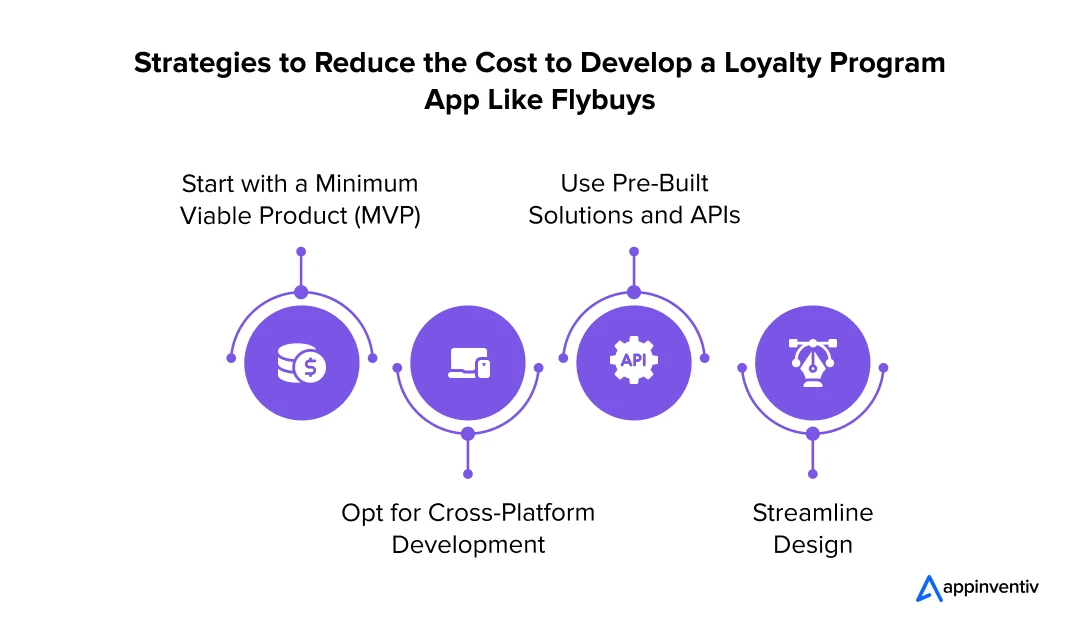
Start with a Minimum Viable Product (MVP)
Focus on the essential features, like loyalty points management and reward redemption, to create a Minimum Viable Product (MVP). This lets you test the app, gather user feedback, and plan for future updates.
Opt for Cross-Platform Development
Using frameworks like React Native or Flutter allows you to create a single codebase for both iOS and Android, cutting development time and costs.
Use Pre-Built Solutions and APIs
Integrating third-party services like Stripe for payments, Twilio for messaging, and Google Analytics for tracking can save on building these features from scratch.
Streamline Design
Consider using pre-designed templates or UI kits that can be customized for your app, maintaining a professional look without heavy design costs.
Key Features That Make Flybuys a Market Leader
A loyalty program app like Flybuys isn’t just about collecting points; it’s an ecosystem designed to enhance customer engagement, drive repeat purchases, and provide valuable insights to retailers. Flybuys has evolved into a multi-brand rewards platform, integrating features that simplify rewards management and make the shopping experience more engaging and rewarding for users. Here’s a breakdown of the core Flybuys-like app development features.
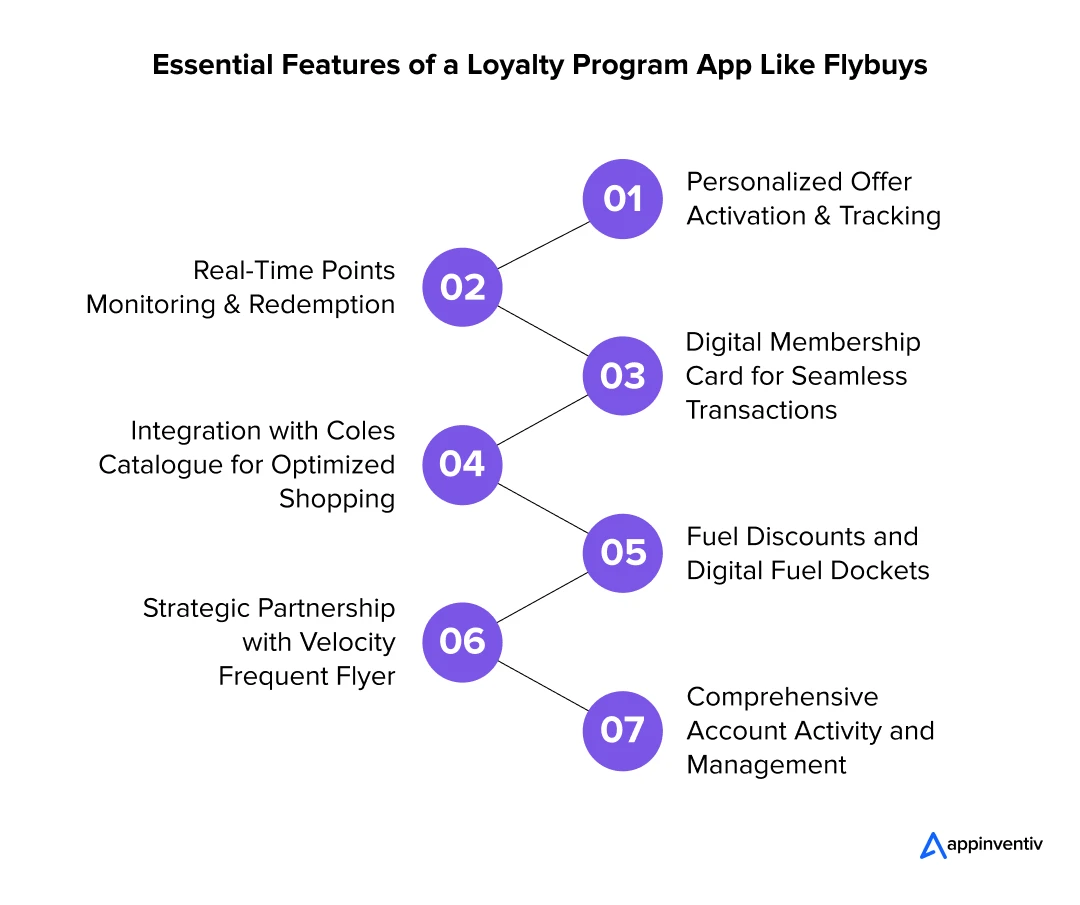
Personalized Offer Activation and Tracking
Central to the Flybuys experience is its sophisticated system of personalized offers. The app uses advanced data analytics to curate bespoke promotions aligned with individual shopping behaviors and preferences.
Users can effortlessly activate these offers within the app, ensuring they maximize their points accumulation during purchases. Moreover, the app provides a dedicated section where users can monitor active and redeemed offers, fostering a sense of control and transparency in their rewards journey.
Real-Time Points Monitoring and Redemption
Transparency is a cornerstone of the Flybuys app. Users have immediate access to their current points balance, allowing real-time tracking of their rewards status. When built right, this one of the most crucial Flybuys-like app development features is complemented by a streamlined redemption process, where points can be exchanged for various rewards, including discounts, gift cards, merchandise, and travel bookings, all within the app’s intuitive interface.
Digital Membership Card for Seamless Transactions
In an era where convenience is paramount, the Flybuys app offers a digital membership card, eliminating the need for physical cards. This virtual card can be scanned directly from the user’s mobile device at checkout, ensuring a frictionless and efficient transaction process.
Users can integrate digital cards into their mobile wallets for added convenience, facilitating quick access during in-store visits. In addition, the brand also offers a physical card for customers to use in stores, which increases the count of factors influencing the cost of the customer loyalty program app.
Integration with Coles Catalogue for Optimized Shopping
The partnership between Flybuys and Coles supermarkets is exemplified by the app’s integration with Coles’ digital catalog. Users can peruse the latest specials and promotions, adding desired items directly to their online shopping cart. This set of features of Australian loyalty programs streamlines the shopping experience and enables users to strategically plan their purchases to maximize point earnings.
Fuel Discounts and Digital Fuel Dockets
Extending its value proposition beyond retail, the Flybuys app offers fuel-related benefits. Users can access digital fuel dockets, which provide discounts at partnered fuel stations. These digital vouchers are stored within the app, ensuring users can easily retrieve and utilize them during refueling, enhancing the overall value derived from the Flybuys program.
Strategic Partnership with Velocity Frequent Flyer
A standout feature of the Flybuys app is its integration with Velocity Frequent Flyer, Virgin Australia’s loyalty program. Members can link their Flybuys and Velocity accounts, enabling the transfer of Flybuys points to Velocity Points.
This synergy allows users to accelerate their progress toward travel rewards, offering a compelling incentive for frequent flyers. Additionally, linked members can earn Velocity Status Credits through eligible Flybuys transactions, further enhancing their travel benefits.
Comprehensive Account Activity and Management
The Flybuys app provides a detailed overview of user activity, encompassing earned, redeemed, and pending points. This transparency allows users to track their engagement with the program meticulously.
Furthermore, the app offers robust account management features, enabling users to update personal information, adjust communication preferences, and manage linked accounts, all within a secure and user-friendly environment.
With these features built into your process to create a platform like Flybuys, your app would deliver a holistic rewards experience, making it an industry leader in customer loyalty programs. All the while, its ability to integrate multiple brands, personalize offers, and streamline redemption set a high benchmark for loyalty apps worldwide.
Design Considerations for Flybuys App
When designing an app like Flybuys customer loyalty programs Australia, the user experience is paramount. The aim is to keep users engaged, ensuring that offers, rewards, and loyalty points are easy to track and manage.
The design should feel intuitive so users can swiftly navigate between various features while receiving personalized content. A thoughtfully structured app with clear visual cues and interactive elements helps maintain user interest and foster long-term loyalty.
Below are some key design elements that can make or break the experience for users of Flybuys while playing a key role in deciding the customer loyalty program app development cost.
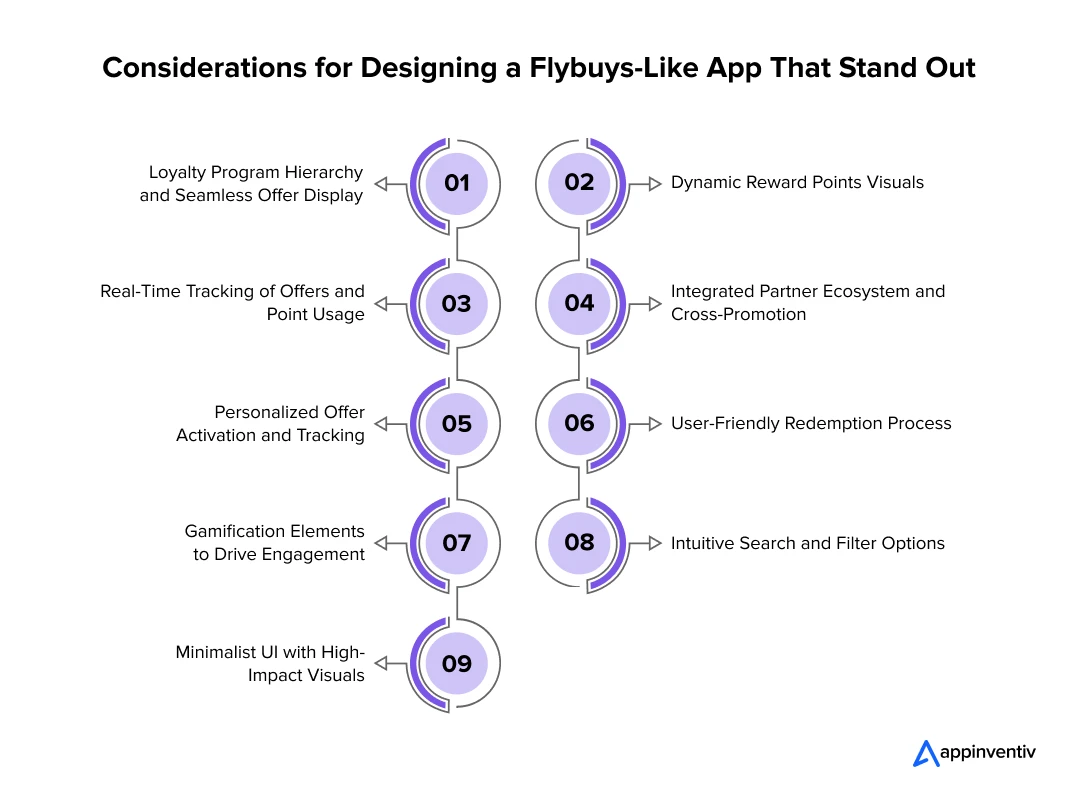
Loyalty Program Hierarchy and Seamless Offer Display
Users should immediately recognize their loyalty status upon opening the app. By clearly displaying premium offers at the top of the screen and organizing them with intuitive categories, the app can allow users to navigate through the rewards that matter most to them quickly. Premium offers and general deals can be color-coded or tagged to provide immediate visual cues, enhancing usability and ensuring users aren’t overwhelmed.
Dynamic Reward Points Visuals
Adding dynamic visuals, such as progress bars or animated point counters, encourages engagement by showing users exactly how far they are from earning rewards. These visual cues create a sense of urgency and excitement, motivating users to interact with the app more often and take advantage of available offers. As users approach key milestones, these visuals can act as a reminder to continue earning points or redeeming rewards.
Real-Time Tracking of Offers and Point Usage
Providing real-time updates on offer activation and points balance is essential for maintaining transparency and trust with Australian loyalty program users. Notifications on rewards status and clear indicators of when offers are about to expire keep users informed. This functionality allows users to make timely decisions, ensuring they never miss out on a valuable opportunity to redeem or earn points.
Integrated Partner Ecosystem and Cross-Promotion
As your app collaborates with numerous retail partners, the design must be crafted to integrate these relationships seamlessly. Users should be able to browse partner offers without feeling like they are navigating separate apps.
A well-organized partner section, where users can find brand offers, would ensure a smooth transition between different ecosystems. Cross-promotion should be subtle but effective, encouraging users to explore various partner deals without overwhelming them with irrelevant options.
Personalized Offer Activation and Tracking
Personalized offers are the core of Flybuys’ appeal, and the design should highlight this. The app should track users’ purchase behavior and activate tailored offers accordingly. Whether through AI or machine learning, the app can present users with discounts or deals based on their previous interactions. An easy-to-find “Offers” tab that shows activated, available, and soon-to-expire offers keeps users engaged and helps them take immediate action.
User-Friendly Redemption Process
A complicated redemption process can frustrate users. When you create a platform like Flybuys, aim to design a simple, seamless flow for redeeming points, whether for discounts, gift cards, or partner deals. Applying rewards directly during checkout at partner stores or online platforms should be integrated with minimal friction. Offering one-click redemption or automatic application of points at checkout enhances user satisfaction.
Gamification Elements to Drive Engagement
Gamification can be incorporated to increase the level of interaction and excitement. For instance, users can earn badges or achievements as they accumulate points, activate offers, or complete tasks. Leaderboards can also be introduced, showcasing top members or offering additional rewards for high performers. This turns the app into an interactive experience that encourages competition and motivates users to remain engaged for longer.
Intuitive Search and Filter Options
Customer loyalty app development should include an intuitive search feature that lets users quickly find offers, stores, or products linked to their points. Advanced filtering options can help narrow down offers based on categories, discounts, or partner brands, reducing frustration and saving time. The search bar should be easily accessible and understand natural language queries, making it easy for users to find exactly what they need.
Minimalist UI with High-Impact Visuals
While it’s important to have all features readily available, the app should avoid a cluttered design. Using clean lines and white space, a minimalist UI helps users focus on what’s most important: offers, point balance, and rewards. High-impact visuals, such as banner ads for limited-time promotions or seasonal offers, should be visually striking but not intrusive, maintaining the app’s elegance while highlighting key deals.
Also Read: A Beginner’s Guide to Designing Minimal UI/UX of Apps
In designing an app like Flybuys, user experience is paramount. Prioritizing personalization, clear navigation, and performance optimization while integrating seamless loyalty program features can drive user engagement and satisfaction. Ensuring technical reliability and intuitive design while adding to the list of factors influencing the cost of customer loyalty program apps helps you create a rewarding and accessible app experience for users, fostering long-term loyalty and enhanced customer retention.
Tech Stack for Building an App Like Flybuys
When you develop a customer loyalty program app like Flybuys, the focus is on scalability, personalization, and seamless integrations. The following technologies, we believe, are well-suited to avail the maximum benefits of building a customer loyalty program app:
| Aspects |
Technologies |
| Frontend Technologies |
- React Native / Flutter
- HTML5, CSS3, JavaScript
- Redux
|
| Backend Technologies |
- Node.js
- Ruby on Rails
- Java
|
| Databases |
- MongoDB
- PostgreSQL
|
| Cloud Infrastructure |
- Amazon Web Services
- Google Cloud Platform
|
| Payment & Integration Tools |
- Stripe / PayPal SDK
- Third-party API – Google Maps API, Mapbox, OneSignal, Firebase Cloud Messaging, Dynamic Yield, Algolia, SendGrid, Mailgun, Tango Card, and Loyalzoo
|
The Development Approaches for Building an App Like Flybuys
When deciding on the customer loyalty program app development process, your approach will significantly affect cost and time-to-market. Whether you’re opting for a lean startup approach or a more traditional development methodology, each has its benefits and trade-offs. The key lies in aligning the development process with your business goals and the complexity of your app’s features while considering the cost of building a customer loyalty program app like Flybuys.
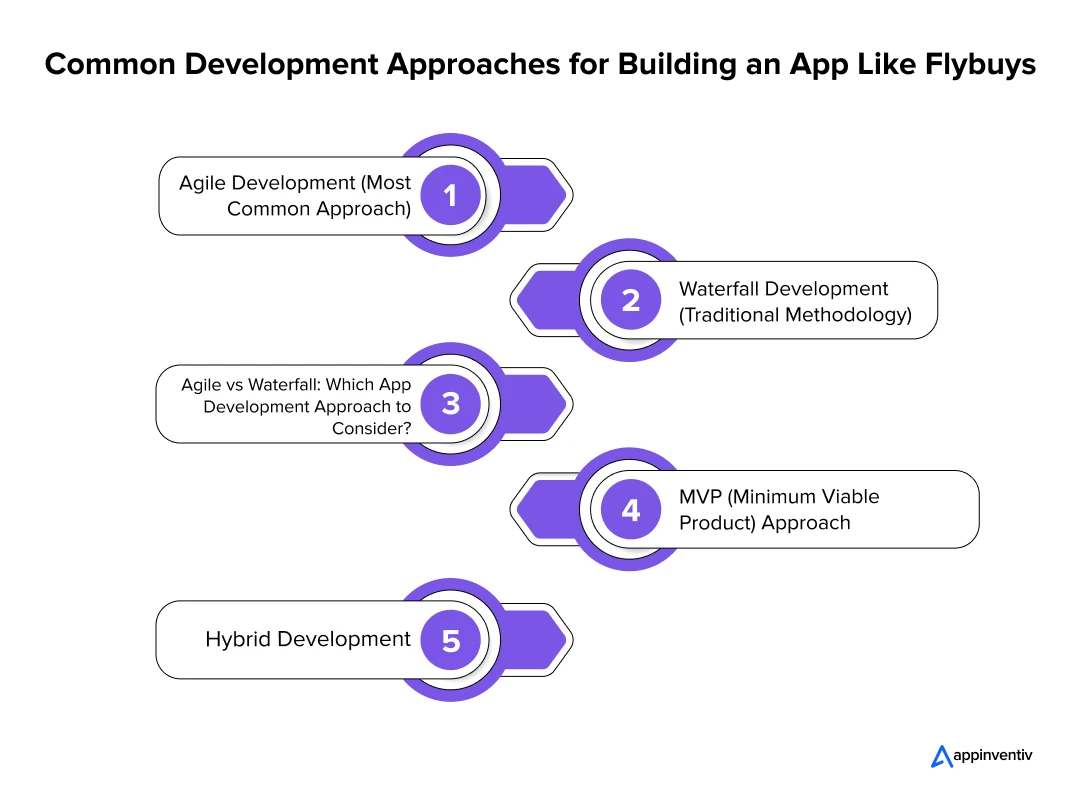
Agile Development (Most Common Approach)
Agile mobile app development allows flexibility, quick iterations, and constant feedback loops. Though it can initially incur higher customer loyalty program app development costs due to the continuous development cycles, it often saves money in the long run by minimizing risk and adapting to market changes.
Why It’s Ideal:
This approach works best for Flybuys as it involves frequent updates to loyalty features, personalized offers, and partner integration. The flexibility of Agile ensures that the app remains aligned with evolving business needs and user expectations.
Waterfall Development (Traditional Methodology)
With Waterfall, all requirements are typically gathered upfront, and the entire app is built according to those specifications. While this approach can lead to a fixed budget, it’s normally less flexible and more costly when changes are needed mid-way.
Why It May Not Be Ideal:
For an app like Flybuys, which needs constant adaptation based on new partners or changing reward systems, a Waterfall model may be too rigid and costly for ongoing improvements.
Agile vs Waterfall: Which App Development Approach to Consider?
MVP (Minimum Viable Product) Approach
The MVP approach of the customer loyalty program app development process helps reduce development costs by initially focusing only on the core features. Launching a basic app version that provides the essential functionalities minimizes resource expenditure during the early stages. Later, the app can be enhanced with more complex features over time.
Why It’s Ideal:
An MVP approach is a great way for startups or companies with limited budgets to enter the market quickly. For example, Flybuys could start with basic loyalty features and gradually expand as the user base grows.
Hybrid Development
Developing a hybrid version of customer loyalty programs in Australia allows the same codebase to be used across both iOS and Android platforms, significantly reducing development costs. However, hybrid apps might come with performance trade-offs, and some advanced features (such as Push Notifications or Location-based services) might require more resources to optimize.
Why It Works:
If you aim for customer loyalty program app development like Flybuys, which needs to be cross-platform but doesn’t require overly complex features in the initial phase, hybrid development can offer a good balance between cost and scalability.
How to Develop a Customer Loyalty Program App Like Flybuys
Developing a customer loyalty program app like Flybuys involves creating a platform that rewards customers for their repeated business. Here are the basic steps to develop such an app.

Market Research
Begin by researching your target market to understand their preferences and behaviors. Use this information to tailor your app’s features and rewards system to meet the specific needs and desires of your audience.
Define Your Rewards System
Design a rewards system that motivates users to engage frequently. Decide how customers will earn points and what they can redeem them for. For example, should you offer discounts, products, exclusive offers?
Choose the Right Technology
Select a technology stack that supports the scalability and security demands of your app. This includes choosing between native, hybrid, or web-based platforms based on your specific needs and budget.
System Design
Design the system architecture and user interface. This step involves translating the requirements into a workable design. The user interface design should focus on creating a seamless and engaging user experience, while the system design should outline the technical blueprint.
Develop a Prototype
Create an initial prototype of your app to visualize the user journey and basic functionality. This early version helps in refining the user interface and gathering initial feedback from test users.
Development Phase
Start the actual coding of the app, focusing on building both the front-end and the back-end. Make sure the app’s core features, like tracking points and redeeming rewards, are developed first.
Integration and Testing
Combine your app with existing systems such as payment gateways and customer databases to ensure everything works together smoothly. Test the app rigorously to find and fix bugs. This includes checking that all parts of the app work correctly on their own and together with other systems.
Deployment
Release your app to the public. This involves installing the app on servers and making it available in app stores. Ensure that the deployment is smooth and monitor the app’s performance as users begin to download and use it.
Maintenance and Updates
Keep an eye on the app’s performance and fix any issues that users report. Update the app regularly to add new features, improve existing ones, and keep the technology up to date.
Flybuys App Monetization Strategies
When you develop a customer loyalty program app like Flybuys that centers around loyalty and rewards, monetization strategies are designed to generate revenue and improve user engagement and retention. These app monetization strategies help brands maintain a constant relationship with their users, rewarding them for continued interaction and purchases.
The following monetization models are industry-tested and frequently adopted by loyalty-based platforms to drive sustainable growth while maintaining a user-first approach and ensuring that the returns on the customer loyalty program app development cost in Australia are huge.
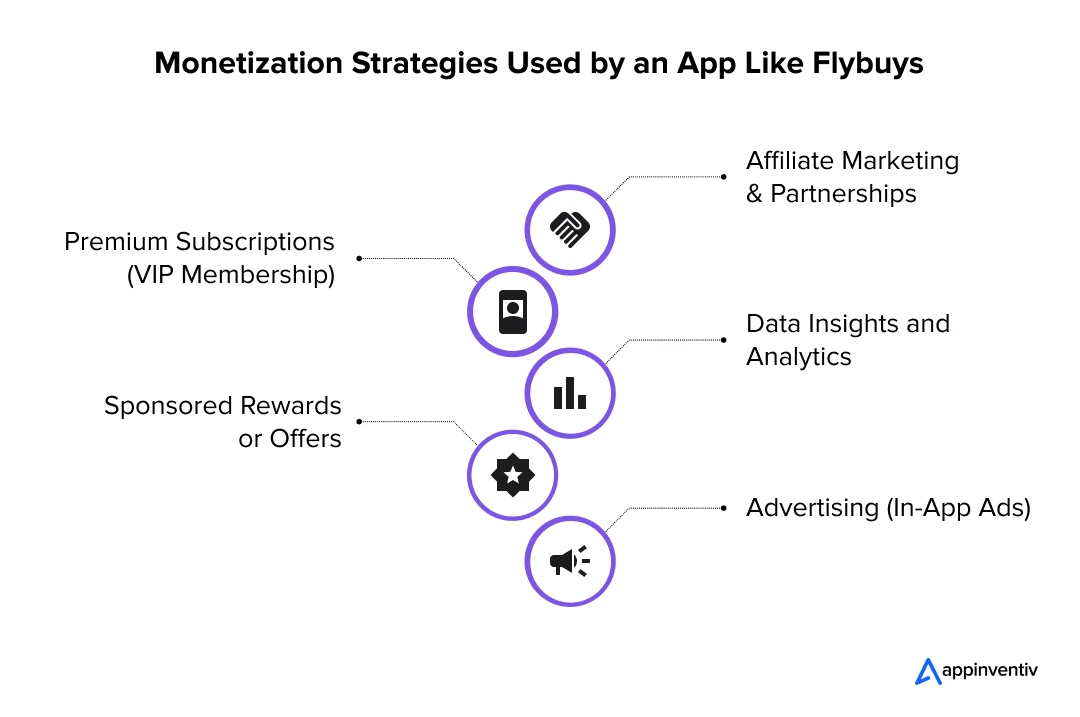
Affiliate Marketing & Partnerships
Partnering with retail brands or service providers, Flybuys earns commissions when users purchase through affiliated links or use their points for a reward.
Premium Subscriptions (VIP Membership)
By offering a VIP membership, Flybuys can unlock exclusive deals, faster point accumulation, and unique rewards for a subscription fee.
Data Insights and Analytics
By gathering insights from user behavior (e.g., preferred brands, spending habits), Flybuys can sell anonymized data to partner companies or leverage it for better-targeted offers.
Sponsored Rewards or Offers
Businesses or retailers can pay to feature their products or services as a sponsored offer within the Flybuys app.
Advertising (In-App Ads)
Flybuys can integrate advertising into the app by displaying banner ads or promotional content relevant to the users.
How Can Appinventiv Support Your Loyalty and Rewards Platform Development?
At Appinventiv, as a trusted mobile app development company in Perth, we understand that building a successful Flybuys-like loyalty and rewards app requires a blend of cutting-edge technology, seamless user experience, and smart monetization strategies.
Our team specializes in designing and developing scalable, secure solutions tailored to your unique business needs. We work closely with clients to ensure their loyalty apps are intuitive, provide personalized experiences, and offer seamless integrations with third-party services like payment gateways, CRM systems, and customer data platforms.
With years of experience specializing in the process of customer loyalty program app development like Flybuys, we can help you design user-centric features that drive engagement and increase customer retention. Whether you’re looking to create a robust backend, integrate reward point systems, or implement analytics tools to track user behavior, we’ve got you covered.
Connect with our in-house specialists to ensure that your cost to build a customer loyalty program app like Flybuys is not just justified but also guarantees you 10X returns.
FAQs
Q. What is a customer loyalty program?
A. A customer loyalty program is a marketing strategy designed to encourage repeat business by offering rewards or incentives to loyal customers. These rewards may include points, discounts, or exclusive offers that accumulate based on customer purchases or engagement. Ultimately, the goal is to increase customer retention and boost sales over time.
Q. Which rewards program app is the best?
A. The best rewards program app depends on the specific needs of your business and your target audience. Apps like Flybuys are highly effective for companies that wish to offer customers personalized rewards. However, depending on factors like industry, reward structure, and user experience, other apps might be more suitable. Evaluating different features, pricing, and customer engagement strategies is crucial before deciding.
Q. Why is a customer loyalty program app important in business?
A. A customer loyalty program app is important because it helps businesses retain customers, increase sales, and build brand loyalty. Companies foster long-term relationships that drive repeat purchases by rewarding customers for their continued business. Moreover, these apps enable businesses to gather valuable customer data, which can be used to personalize offers and enhance the customer experience.
Q. How long does making a customer loyalty program app like Flybuys take?
A. The timeline to develop a customer loyalty program app like Flybuys typically ranges from 6 to 12 months. The timeline depends on the complexity of the features, integrations, and platform chosen for development. The development time may be longer for a feature-rich app with personalization, loyalty point systems, and third-party integrations.
Q. How much does it cost to build a customer loyalty program app like Flybuys?
A. The customer loyalty program app development cost varies based on the complexity of the features and the development team. For a basic app, the cost to create a platform like Flybuys can start around $50,000–$100,000, but for more advanced apps with personalized offers, integrations, and analytics, the price can range from $150,000 to $300,000 or more.
Product Development & Engineering
IT Managed & Outsourcing
Consulting Services
Data Services
Didn't find what you're looking for? Let us know your needs, and we'll tailor a solution just for you.




